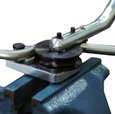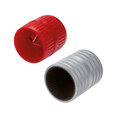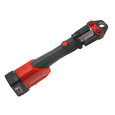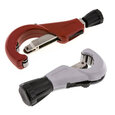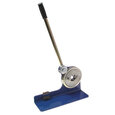The Importance of Pipe Deburring: Tools, Techniques, and Benefits
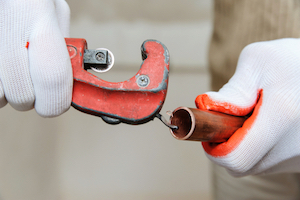
Figure 1: Deburring a copper pipe after cutting
Using a pipe deburrer to remove burrs from a pipe end has many benefits, but the main purpose is to prepare pipes for a connection point. Also, deburring makes pipes safer by removing sharp edges. In the case of exposed pipes, deburring makes them more visually appealing. Several tools and techniques are used for pipe deburring, which are covered in this article.
A burr is a raised, rough edge that forms when a piece of metal is cut or machined, negatively impacting performance and safety. Burrs on pipes form when copper pipes are cut and have the following negative consequences:
- Impaired flow: Burrs inside the pipe interfere with liquid and gas flowing through the pipe. This can create turbulence and pressure drops.
- Leakage: Burrs can damage connectors during installation, preventing proper sealing.
- Damage to equipment: A pipe that connects directly to a valve or pump must be free of burrs to avoid damage to internal seals and surfaces.
Check out our selection of pipe and tube processing tools!
Pipe deburring tools
There are several different tools available for deburring pipes. Choosing between them comes down to:
- Cost and availability: Simple tools like sandpaper or a file are highly available and inexpensive. Complex tools like tube deburring and chamfering machines require a much higher initial investment.
- Job type: A simple DIY job can be done using a simple tool, whereas commercial and industrial deburring jobs can be accomplished more efficiently using automated machines.
File
Files have rough surfaces with small cutting edges called teeth. Held against the pipe, the file's teeth move back and forth and gradually shave off the burrs. Hold a file perpendicular to the burr and periodically check visually or with fingers to determine whether the burr has been shaved off. The primary advantage of files is that they are inexpensive and available. Also, they can deburr pipes of various sizes and provide precise control to deburr all sharp edges.
Sandpaper
Sandpaper has a paper or cloth backing coated with abrasive particles. It comes in various grit sizes, which indicates how abrasive the material is. The lower the grit, the coarser the sandpaper is. When selecting sandpaper for pipe deburring, start with a low grit and work up to higher grit. For example,
- Copper pipes: Start with 100 grit and work up to 400 grit.
- Stainless steel pipes: Start with 100 grit and work up to 1200 grit.
Like files, sandpaper is readily available and inexpensive. Also, it can form to the pipe, allowing it to shave off more burrs. A downside to sandpaper is that it's labor intensive, and getting the grit right can be trial and error. Also, sandpaper is not suitable for larger burrs.
Pipe deburrer tool
Pipe deburrer tools are specifically designed for deburring pipes. These tools have different designs. As seen in Figure 2, some pipe deburrers have handles (Figure 2 left), and others do not (Figure 2 right).
- The tools with handles use a blade to scrape off tools inside and outside.
- The tool without a handle has two sides, one side inserts into the pipe, and the other fits around the pipe end. The user rotates the tool to scrape off burrs.
The primary disadvantage of pipe deburrer tools is especially seen with the tool without a handle. This tool style is sized for specific pipe diameters and is not as versatile as other deburring tools.

Figure 2: Deburring tools come in different designs.
Tube deburring machine
Tube deburring machines use automated processes to efficiently and accurately deburr pipes. They can be changed to work with different pipe sizes and handle high-volume tasks. Typically, pipes are fed into the machine, which has cutting, grinding, or brushing mechanisms to remove burrs.
Tube deburring machines are ideal for commercial and industrial applications that must deburr large amounts of pipe as efficiently as possible. These machines are too expensive to make them suitable for the DIYer who needs to deburr a pipe now and then. Also, these machines require more space and maintenance.
Chamfering machine
Chamfering machines make beveled edges on pipe ends, making them easier to fit into connectors. The machine's cutting tool removes pipe end material, which results in a smooth, angled surface free of burrs. These machines can be manual or automatic. Chamfering machines are efficient and provide a nice finished pipe end. The primary downside is their high initial cost.
Deburring techniques
There are several different deburring techniques. The most commonly used technique is manual deburring, which uses files, sandpaper, and deburring tools. Automated deburring uses tools such as a tube deburring machine or chamfering machine. Other techniques include:
- Chemical deburring: Chemical deburring uses deburring solutions or electrochemical processes to deburr pipes. This deburring technique is appropriate for complex or difficult-to-reach areas, such as pipes with intricate internal passages. Also, the chemical deburring technique is used on pipes made of delicate materials that cannot withstand mechanical deburring. Finally, chemical deburring is used for processing large batches of pipes.
- High-pressure water jet deburring: High-pressure water jet deburring uses water jets to remove burrs from pipes. This technique is suitable for softer pipe materials, such as plastic pipes. Also, this technique can remove larger burrs as well as other loose particles. Finally, this process also cleans the surface of the pipe, preparing it for coating or welding.
- Ultrasonic deburring: Ultrasonic deburring uses ultrasonic vibrations and abrasive media to remove burrs. This technique is suitable for intricate and delicate pipe designs. Also, it can remove very fine burrs, such as microscopic burrs, that are difficult to remove with other deburring methods.
FAQs
What is a pipe deburrer?
A pipe deburrer is a tool that mechanically removes burrs from a pipe end. These tools have different designs but offer the same basic function.
What is the difference between a reamer and a deburrer?
Reamers expand the diameter of a pipe end, whereas pipe deburrers clean and smoothen a pipe end.




